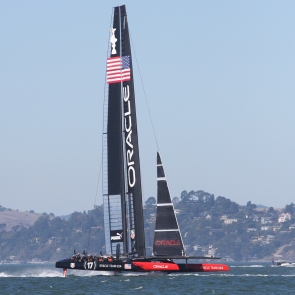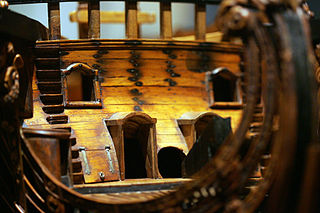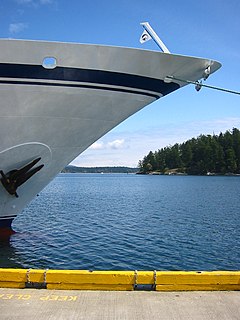
Sailing employs the wind—acting on sails, wingsails or kites—to propel a craft on the surface of the water, on ice (iceboat) or on land over a chosen course, which is often part of a larger plan of navigation.

Solar sails are a proposed method of spacecraft propulsion using radiation pressure exerted by sunlight on large mirrors. A useful analogy may be a sailing boat; the light exerting a force on the mirrors is akin to a sail being blown by the wind. High-energy laser beams could be used as an alternative light source to exert much greater force than would be possible using sunlight, a concept known as beam sailing.

A sloop is a sailing boat with a single mast and a fore-and-aft rig. A sloop has only one head-sail; if a vessel has two or more head-sails, the term cutter is used, and its mast may be set further aft than on a sloop.

Galleons were large, multi-decked sailing ships first used by the Spanish as armed cargo carriers and later adopted by other European states from the 16th to 18th centuries during the age of sail and were the principal fleet units drafted for use as warships until the Anglo-Dutch Wars of the mid-1600s. Galleons generally carried three or more masts with a lateen fore-and-aft rig on the rear masts, were carvel built with a prominent squared off raised stern, and used square-rigged sail plans on their fore-mast and main-masts.

In the rating system of the British Royal Navy, a third rate was a ship of the line which from the 1720s mounted between 64 and 80 guns, typically built with two gun decks. Years of experience proved that the third rate ships embodied the best compromise between sailing ability, firepower, and cost. So, while first rates and second rates were both larger and more powerful, the third-rate ships were in a real sense the optimal configuration.

Anton Engelbert "Toni" Sailer was an Austrian alpine ski racer, considered among the best in the sport. At age 20, he won all three gold medals in alpine skiing at the 1956 Winter Olympics. He nearly duplicated the feat at the 1958 World Championships with two golds and a silver. He also won world titles both years in the combined, then a "paper" race, but awarded with medals by the International Ski Federation (FIS).

A tall ship is a large, traditionally-rigged sailing vessel. Popular modern tall ship rigs include topsail schooners, brigantines, brigs and barques. "Tall ship" can also be defined more specifically by an organization, such as for a race or festival.

The caravel was a small, highly maneuverable sailing ship developed in the 15th century by the Portuguese to explore along the West African coast and into the Atlantic Ocean. The lateen sails gave it speed and the capacity for sailing windward (beating). Caravels were used by the Portuguese and Castilians (Spain) for the oceanic exploration voyages during the 15th and 16th centuries in the Age of Discovery.

The Age of Sail was a period roughly corresponding to the early modern period in which international trade and naval warfare were dominated by sailing ships, lasting from the mid-16th to the mid-19th century.

The Optimist, also known as the 'bathtub', is a small, single-handed sailing dinghy intended for use by children up to the age of 15. Contemporary boats are usually made of fibreglass, although wooden boats are still built.

A chase gun, usually distinguished as bow chaser and stern chaser was a cannon mounted in the bow or stern of a sailing ship. They were used to attempt to slow down an enemy ship either chasing (pursuing) or being chased, when the ship's broadside could not be brought to bear. Typically, the chasers were used to attempt to damage the rigging and thereby cause the target to lose performance.

The mast of a sailing vessel is a tall spar, or arrangement of spars, erected more or less vertically on the centre-line of a ship or boat. Its purposes include carrying sail, spars, and derricks, and giving necessary height to a navigation light, look-out position, signal yard, control position, radio aerial or signal lamp. Large ships have several masts, with the size and configuration depending on the style of ship. Nearly all sailing masts are guyed.

A full-rigged ship or fully rigged ship is a sailing vessel's sail plan with three or more masts, all of them square-rigged. A full-rigged ship is said to have a ship rig or be ship-rigged.

A launch is an open motorboat. The forward part of the launch may be covered. Prior to the era of engines on small craft, a launch was the largest boat carried on a sailing vessel, powered by sail or by oars. In competitive rowing, a launch is a motorized boat used by the coach during training.

Full Sail University is a private, for-profit university in Winter Park, Florida. It was formerly a recording studio in Ohio named Full Sail Productions and Full Sail Center for the Recording Arts. Full Sail moved to Florida in 1980, running video and film production courses. It began offering online degrees in 2007. The school is partly owned by TA Associates, a private equity firm.

The Laser 3000 is a racing sailing dinghy crewed by two persons with a trapeze for the crew. Launched in 1996, the 3000 was developed from the Laser 2, using the original Frank Bethwaite-designed planing hull combined with a brand new self-draining deck by Derek Clark. Clark also re-designed the rig, using spars and sails from premium proprietary sources and replacing the symmetric spinnaker of the Laser 2 by a larger asymmetric spinnaker (gennaker). The gennaker is chute-launched and retrieved using a single halyard line, and is set on a retractable bowsprit. Helm balance and handling were improved using a shorter-footed mainsail with two full-width battens giving a larger roach. A mast with conventional spreaders replaced the now-unusual diamond arrangement of the Laser 2.

The Sail and Steam Navy List: All the Ships of the Royal Navy 1815–1889 by Rif Winfield and David Lyon is a historical reference work providing details of all recorded ships in commission or intended to serve in the Royal Navy from 1815 to 1889. Where available in Admiralty records, it gives the location of construction, dates of construction, principal dimensions and tonnage, armament, machinery and fate of every ship of the Royal Navy over the period.
The Splash Dinghy is 3.5 m in length and all boats are identical, thus, as is typical in One-Design classes, the sailor's ability rather than equipment is emphasised fleet racing. The boats employ an un-stayed mono rig with a sail area of 6.3 m2, which makes the class easy to handle by sailors ranging from 45 to 80 kg. This, combined with the low hull weight of 55 kg, allow the class to serve as a stepping stone between the Optimist Dinghy and boats such as the Laser Radial, suiting Sailors in the age range from 13 to 21 years.

A sail is a tensile structure—made from fabric or other membrane materials—that uses wind power to propel sailing craft, including sailing ships, sailboats, windsurfers, ice boats, and even sail-powered land vehicles. Sails may be made from a combination of woven materials—including canvas or polyester cloth, laminated membranes or bonded filaments—usually in a three- or four-sided shape.

The lug sail, or lugsail, is a fore-and-aft, four-cornered sail that is suspended from a spar, called a yard. When raised the sail area overlaps the mast. For "standing lug" rigs, the sail remains on the same side of the mast on both the port and starboard tacks. For "dipping lug" rigs, the sail is lowered partially to be brought around to the leeward side of the mast in order to optimize the efficiency of the sail on both tacks.





















